Music of Brittany
Since the early 1970s,
Traditional Breton music
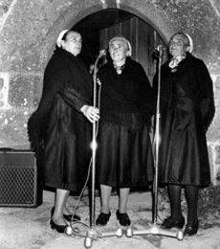
Traditional Breton folk music includes a variety of vocal and instrumental styles. Purely traditional musicians became the heroes of the roots revival in the second half of the 20th century, notably the
Vocal music

Kan ha diskan (roughly translated as call and response singing) is probably the most common type of Breton vocal music, and is the most typical style to accompany dance music. It has become perhaps the most integral part of the Breton roots revival, and was the first genre of Breton music to gain some mainstream success, both in Brittany and abroad.
The lead singer is the kaner, and the second singer is the diskaner. The kaner sings a phrase, and the diskaner sings the last few lines with the kaner, then repeats it alone until the same last few lines, when the kaner again joins in. The phrase's repetition is changed slightly in each execution. Kan ha diskan can be songs about any subject, but must meet one of a number of meters used in folk dances, mostly
In addition to the Goadecs, the singer
It was, however, Ropars who adapted the
Kantikoù (hymns)
Gwerzioù and sonioù (laments and ballads)

Gwerzioù and sonioù are the two primary classifications of Breton unaccompanied folk songs. Vocals for both types are usually by a soloist. A gwerz is a lament characterized by a gloomy tone and subject matter. A Gwerz typically describes tragic events such as murders, deaths, wars, forced emigration or lost love.
Performers in this field include Jean Le Meut from Vannes, whose songs are mostly of the sonioù variety, and are typically pastoral songs concerning love and marriage. More contemporary singers include Iffig Troadeg, who focuses on lyrically shocking gwerzioù, Patrick Marie, Marthe Vassalo, Klervi Rivière, Mathieu Hamon, Annie Ebrel, Erik Marchand and Denez Prigent.
Chants de marins (sailor songs)
The chants de marins, are shanties, ballads about shipwrecks, sailing and loss of life, often accompanied by instruments such as the fiddle and accordion.
Although it is not exclusively Breton, the large number of sailors in this region have given this form of musical expression a high-profile. The best known modern performers are
There is an annual Chants de marins contest in the small town of Paimpol, in north Brittany, where the most famous shantymen of the world meet. At any harbour festival in Brittany Chants de marins can usually be heard.
Instrumental music
Since the Breton folk music revival, Scottish bagpipes and Irish harps have been added to the Breton repertoire, though Brittany retains its own unbroken piping traditions as well as mainstay instruments such as the bombard.
Celtic harp

Though the harp had been common in Brittany in the Middle Ages[citation needed], the instrument had disappeared by the 18th century, at least in its specific repertoire and making. Early in the 20th century, a Breton harpist Paul Diverres living in Wales came several times to play in Brittany. Just before and after the Second World War, Gildas Jaffrenou built a harp from the 14th-century plans for the Brian Boru model. But this was not enough for a revival.
In 1952–1953,
Modern Breton performers include Myrdhin, An Triskell, Kristen Nogues and Dominig Bouchaud.
Violon
The violon (which can mean either fiddle or violin[clarification needed]) is an instrument played across France. Perhaps because of this wide-ranging appeal and lack of regional uniqueness, the instrument was somewhat ignored during the Breton folk revival in the mid-20th century. However, the instrument remains a common part of Breton folk bands today.
The violon has been played in Brittany since at least the 17th century, and was possibly the most widespread instrument in the land by the early 20th century. It was only a few decades later, however, that the accordion nearly wiped the violon out, and most fiddlers joined Irish bands, moved into jazz or otherwise left the instrument. The violon survived, however.
Clarinet (treujenn-gaol)
The clarinet was invented in Germany in the 18th century. It evolved from earlier single reed instruments such as the renaissance chalumeaux, or schalmei. Clarinets were quickly incorporated into orchestras, from where they moved into marching bands and the amateur musicians in them. By the 19th century, the clarinet had entered a number of folk traditions and spread to many parts of the world. In Brittany, the instrument is called a treujenn-gaol (Breton), which translates as cabbage stalk.
The traditional Breton clarinet usually has only 13 keys (though sometimes as few as six), in contrast to the more common 'Boehm' instrument used in jazz, classical music and other fields. This is because classical musicians discarded the clarinets with fewer keys in favor of more complex and state-of-the-art pieces.
After a decline in use in traditional music, the instrument came back, notably in the music of the bagad and paired with the accordion.
In Breton music, two clarinetists typically play together, though they also play in ensembles with accordions and violins. The clarinet is a common part of Breton jazz bands, along with saxophones and drums, playing both jazz and traditional songs.
The best-known Breton clarinetists are probably Erik Marchand, a former member of both Quintet Clarinettes and Gwerz, Gallo musician Yves LeBlanc, and Christian Duro, who plays in the group Termajik. The bands Darhaou, Tonnerre de Brest, L'Echo, Cabestan and Strobinell have also used clarinets.
Guitar
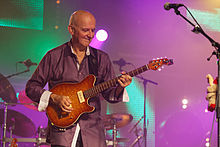
Perhaps the earliest popularizer of Breton guitar was Dan Ar Braz, who continues to be an influential figure in a somewhat jazzy, easy-listening vein. In the traditional music world, Soïg Siberil emerged as the pre-eminent master of 'open tuning' in bands such as Gwerz and Kornog, developing a complex accompaniment and solo technique easily comparable to that of artists such as John Renbourn or Pierre Bensusan. Another guitarist of note is Gilles Le Bigot, who performed with Kornog as well and has been a mainstay of the Breton super-group Skolvan for more than 20 years. Other notable Breton guitarists include Jacques Pellen, Pat O'May, Nicolas Quemener, Fabrice Carre, Roland Conq and Arnaud Royer, who has developed a unique and complex self-accompaniment technique based on sampling and then playing along with loops of his own work.
Wooden flute
The wooden transverse
Accordion
The accordion only arrived in large numbers in the country in about 1875, but its popularity grew quickly. Among the reasons for this were the instrument's cheapness and durability, which could be played solo, and was easier to learn. Perhaps the most important reason, though, was the instrument's association with 'kof ha kof' couples dancing like waltzes and mazurkas, which stood in stark contrast to the line and round dances familiar in Breton folk; the perceived sexuality of the instrument's common dances may have made it more attractive. By the 1920s, the instrument was more popular than any other. In the 1930s, chromatic accordions arrived in Brittany and jazz-influenced bands with saxophones, drum kits and banjos were formed.
Contemporary accordionists include Cocktail Diatonique, Regis Huiban, Bruno Le Tron, Patrick Lefebvre, Yann Dour, Yann-Fañch Perroches and Alain Pennec.
Bagpipes

There are two types of bagpipes indigenous to Brittany. The
Veuze
The veuze has a chanter of conical bore fitted with a double reed and a drone fitted with one reed, both attached to a mouth-inflated bag. Its sound and design are similar to Flemish pipes and Galician gaita. In the 20th century, the term veuze came to be applied to the diatonic accordion, which had been recently imported, and the use of the bagpipes declined. Though still not common, it has rebounded since the Breton folk revival.
Binioù bras
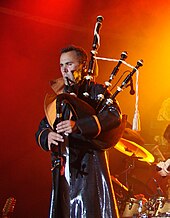
The binioù bras (literally the "big binioù"), or Great Highland bagpipe, was imported in the late 19th century, and became popular in the 1930s. It is now used in solo performances, along with a bombarde in a duo, and as part of the bagad, a kind of pipe band.
The idea of the bagad comes from World War II: Breton soldiers saw pipe bands in Scotland, and brought the idea and instrument back with them to Brittany. There, they added bombardes along with the bagpipes drums and called the ensemble bagad ("company" in Breton). These ensembles gained in popularity in the 1950s, just before the folk revival began, and remain very popular to this day.
Binioù kozh
The binioù kozh is more traditional and predates the introduction of the highland bagpipes to Brittany. It was originally designed from the veuze in order to play in a higher register. Its pitch is higher and its chanter smaller than any other European bagpipe. Originally, it was common in the Breton-speaking area. It is often played as part of a duo with the bombarde, for dance accompaniment.
Bombard
The
In its most primitive form the bombard has six open holes and possibly a seventh that is often closed with a key. It has a range of just over an octave. Bombards come in a number of keys, based on region or intended use. B-flat is a popular choice for those playing in a Bagad alongside the binioù braz (Scottish Highland pipes). In the contemporary setting bombards may also have complex simple system key-work enabling significant chromatic possibilities. In Breton, the bombard is also known as the talabard, and a bombard player as a talabarder.
The bombard has been in use since the 15th century, and has traditionally been played as part of a duo with the binioù kozh since the French Revolution. Later, in the 19th century, the binioù braz (highland bagpipe) was introduced to Brittany.
Biniou and bombarde duos include Jean Baron and Christian Anneix, Youenn Le Bihan and Patrick Molard, and Pierre Crépillon and Laurent Bigot.
In recent years the bombard has been paired and recorded with other instruments not traditionally associated with Breton folk music, such as the organ. Sacred music is well served by the clear, strong sound of the bombard, in combination with the traditional organ. The late Jegat and Yhuel are renowned for this use of the bombard.
Piston
Breton musician, teacher, and luthier Youenn Le Bihan invented the piston in 1983. The piston is a contemporary development of the hautboy or baroque oboe, influenced by the bombard. It is typically rooted in the key of D and features simple system key-work to expand its range. The tone of the piston stands in a warm and rich middle ground between the trumpet-like tone of the bombard and that of the baroque oboe.
Breton pop music
This section may be a rough translation from French. It may have been generated, in whole or in part, by a computer or by a translator without dual proficiency. (September 2022) |
This section needs additional citations for verification. (September 2022) |
Undoubtedly the most famous name in modern Breton music is
In 1955, he began playing the
February 28, 1972, marks the unprecedented performance of the Breton musician, at the
Stivell's most important contribution to the Breton music scene, however, has probably been his importation of rock and other American styles, as well as the formation of the idea of a Breton band. From the album
Inspired by

The most famous group of Breton musicians after Alan Stivell is
Another famous band is Soldat Louis, from Port Louis, across the harbour from the city of Lorient. More rock-oriented, they play modern compositions about Brittany and life on the sea ("Du rhum, des femmes", "Martiniquaise", "Pavillon noir"). Also from the 80s, Ar Re Yaouank played lively driving folk rock songs with pro-Breton themes.
Red Cardell crosses over roots music from Brittany, Ukraine or North Africa with Rock and French realistic songs. Many times they play on stage with guests such as Dave Pegg (Fairport Convention, Jethro Tull), Jimme O'Neill (The Silencers), Dan Ar Braz, Dr Das (Asian Dub Foundation) or Stéfane Mellino (Les Négresses Vertes)... Their album "soleil blanc" has been recorded and mixed by the English producer Clive Martin (Queen, Sting, David Byrne...) Similarly, EV combined Finnish influences in their Breton folk-rock style, calling it Celto-Finnic rock.

Since then, a new scene of Breton songwriters appeared in Brittany (Gérard Jaffrès, Nolwenn Korbell, Dom Duff).
Les Ramoneurs de menhirs do Celtic punk, playing original songs, traditional ones and cover versions mostly in Breton.
Besides folk-rock, recent groups have included, as well as
The band Merzhin uses traditional Celtic instruments along with electric guitars and bass. Their melodies and harmonies are inspired by Celtic music as well as by modern rock and roll.[2]
In the USA, the group Trouz Bras("Big Noise") is led by Welshman Ray Price. The group is based in Rhode Island and features bombarde and Breton bagpipes. In Seattle, Washington a Fest Noz group called Sonerion features piston, bombard, guitar/bouzouki, accordion, and bass. In Austin, Texas, Poor Man's Fortune [1] is well known for performing Breton music featuring biniou, bombarde, accordion, subois (similar to the "piston"), violin, flute and biniou braz.
Brittany hosts many annual rock and pop festivals, not related to traditional music. The biggest in Brittany and France, and one of the most important in Europe, is the
For its 2014 edition, the Festival des Vieilles Charrues (The festival of old plows) announces its new creation: The Celtic Social Club, a supergroup of seven Breton musicians and others, which included Jimme O'Neill (The Silencers), Ronan Le Bars (Héritage des Celtes) and the three members of Red Cardell.
Chanteurs engagés
A chanteur engagé (literally [ideologically] engaged singer) is a singer who is roughly analogous to a singer of protest songs. These songs are usually nationalistic and are celebrations of Breton culture. This is mostly a modern tradition, though some older songs of this type are known and the tradition stretches into the ancient past of Brittany. Chanteurs engagés are often also singers of more traditional material.
The first chanteur engagé to be quoted is the maverick Glenmor (1931–1996), or to give him his real name, Emile Le Scanf (or Milig Ar Scañv in Breton). He had some influence, mainly in the Breton movement and around, and on some newcomers as the best known, Gilles Servat, whose "La Blanche Hermine" has been a popular Breton anthem since the 1970s.
Gallo

Though the Breton folk revival focused on songs in Breton, the Pays Gallo area of eastern Brittany has seen a more limited revival in repertoire in Gallo and produces singers and groups including Hamon-Martin Quintet, Ôbrée Alie, Yann Dour, while various bands, such as Tri Yann, perform a selection of Gallo songs.
Breton artists
Breton singers and musicians
- Jean-Michel Alhaits
- Dan Ar Braz (guitar, voice)
- Andrea Ar Gouilh (voice)
- Anne Auffret (voice)
- Stéven Bodénès (bombard)
- Jorj Botuha
- François Budet

- Kevin Camus (uilleann pipes)
- Louis Capart (voice)
- Jean-Michel Caradec (voice)
- Cécile Corbel (harp, voice)
- Dom Duff (voice)
- Didier Dréo (guitar)
- Annie Ebrel (voice)
- Louise Ebrel (voice)
- Yvon Etienne (voice)
- Yffig Flatrès (voice)
- Glenmor (voice)

- Soeurs Goadec (Goadec sisters), (voices)
- Brieg Guerveno (guitar, voice)
- Frères Guichen (Guichen brothers), (guitar, accordion)
- Gwenynn (voice)
- Youenn Gwernig (voice)
- Gérard Jaffrès (guitar, voice)
- Yann-Fañch Kemener (voice)
- Nolwenn Korbell (voice)
- Krismenn (voice)
- Pascal Lamour (voice)
- Clarisse Lavanant (voice)
- Ronan Le Bars (uilleann pipes, Low whistle)
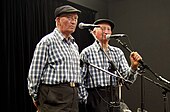
- Jean-Louis Le Hénaff (bombard)
- Gilles Lehart
- Hervé Le Meur(bagpipe)
- Nolwenn Leroy (voice)
- Erik Marchand (voice)
- Patrice Marzin (guitar)
- Miss Blue(DJ)
- Christophe Miossec(voice)
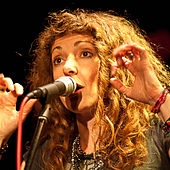
- Gildas Moal and Rene Chaplain
- Jean-Michel Moal (accordion)
- Jacky Molard (violin)
- Frères Morvan (voices)
- Kristen Nikolas (voice)
- Jacques Pellen (guitar)
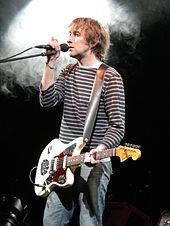
- Yann-Fañch Perroches
- Denez Prigent (voice)
- Loeiz Ropars (bagpipe)
- Erwan Roparz (bagpipe)
- Jean-Luc Roudaut (voice)
- Soig Siberil (guitar)
- Didier Squiban (piano)
- Alan Stivell (harp, bombard, voice)
- Bernez Tangi (voice)
- Yann Tiersen (violin, accordion, guitar)
- Michel Tonnerre (voice)
- Marthe Vassalo (voice)
- Jean Michel Veillon (flute)
- Wonderbraz (DJ)
Breton bands
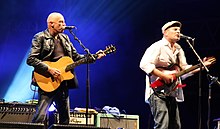
- Armens
- Ar Re Yaouank
- Bleizi ruz
- Cabestan
- Carré Manchot
- The Celtic Social Club
- Daonet
- Diaouled Ar Menez
- Diwall
- Djiboujet
- EV
- Forzh Penaos
- Gweltaz Ar Fur
- Gwendal
- Gwenfol
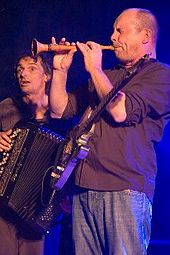
- Kern
- Kreiz Breizh Akademi
- Matmatah
- Merzhin
- Octopus Kafé
- Penn Gollo
- Plantec
- Les Ramoneurs de menhirs
- Red Cardell
- Skeduz
- Skolvan
- Soldat Louis
- Sonerien Du
- Startijenn
- Storlok
- Tri Yann
Breton bagads (Pipe bands)

- Bagad An Hanternoz
- Bagad Ar Meilhoù Glaz
- Bagad Ar Re Goz
- Bagad Beuzeg ar C'hab
- Bagad Bleimor
- Bagad Blouarzel
- Bagad Brieg
- Bagad Bro Felger
- Bagad Bro Kemperle
- Bagad Bro Landerne

- Bagad Cap Caval
- Bagad de Cesson-Sévigné
- Bagad Elven
- Bagad Eostiged Ar Mene
- Bagad Ergué-Armel
- Bagad Glaziked Pouldergat
- Bagad Gwengamp
- Bagad Kadoudal
- Bagad Karreg An Tan
- Bagad Karaez
- Bagad Kemper

- Bagad Keriz
- Bagad Kerlenn Pondi
- Bagad Kevrenn Alre
- Bagad Kevrenn Brest Sant Mark
- Bagad Kombrid
- Bagad Konk Kerne
- Bagad Landi
- Bagad de Lann-Bihoué
- Bagad Melinerion
- Bagad Naoned
- Bagad Pãnvrid
- Bagad Penhars

- Bagad Plougastell
- Bagad Quic-en-Groigne
- Bagad Roñsed-Mor
- Bagad Sant-Brieg
- Bagad Saint-Nazaire
- Bagad Sonerien An Orient
- Bagad Sonerien Bro Dreger
- Bagad Spered An Avel
References
- ^ See Fest Noz Spezet.
- ^ "Merzhin.Net - le site officiel de Merzhin". Archived from the original on 28 August 2002.
Sources
- Jonathyne Briggs, Sounds French: Globalization, Cultural Communities, and Pop Music in France, 1958-1980, ISBN 9780199377091
- Winick, Stephen D. "Brittany". 2001. In Mathieson, Kenny (Ed.), Celtic music, pp. 110–139. Backbeat Books. ISBN 0-87930-623-8
- Ronan Gorgiard "L'étonnante scène musicale bretonne", Palantines (Ed.), collection : Culture et patrimoine, 2008, 255 pages. ISBN 978-2-911434-98-3
Films
- Of Pipers and Wrens (1997). Produced and directed by Gei Zantzinger, in collaboration with Dastum. Lois V. Kuter, ethnomusicological consultant. Devault, Pennsylvania: Constant Spring Productions.

